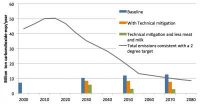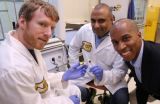(Press-News.org) A research group at Uppsala University, Sweden has developed a new responsive coating for implants used in surgery to improve their integration into bone and to prevent rejection. Neutron scattering experiments at the Institut Laue-Langevin (ILL) in Grenoble, France have shown how a protein that promotes bone growth binds to this surface and can be released in a controlled way.
Orthopaedic and dental implants must last for many years. Success for these surgical components depends on integration into adjacent bone tissue. Gels made by modifying hyaluronan, a large biological molecule, can be used to coat implants. A new paper in Advanced Engineering Materials shows that the coated titanium surfaces can bind protein molecules which promote bone formation. These can be released slowly once the surface comes in contact with a solution of calcium ions. This process would stimulate the growth of bone on the implant.
The gel layers, a few millionths of a millimetre thick, were characterised using neutron reflection at the ILL, a technique that provides a detailed picture of what happens at a surface. In their new paper the research team showed that the protein, BMP-2, that encourages bone growth was bound to the gel. They also demonstrated that the layer of protein was stable in water but could be released slowly by adding solutions containing calcium, a process that was observed in real time using neutron reflection to track the amount of protein at the surface.
The research group has now launched trials of similar materials for metal implants in rabbits. These ongoing studies are made in collaboration with the Swedish Agricultural University in Uppsala and they provide a step towards transfer of the results to clinical applications.
'Interdisciplinary research and partnerships allow advanced analytical tools to be applied to important but difficult medical and scientific challenges. This exciting work comes from shared goals of chemists and physicists as well as the Centre for Neutron Scattering at Uppsala University and the laboratories in Grenoble', says Professor Adrian Rennie.
'We envisage that the materials will be used in medicine to modulate the healing process in bone', says Associate Professor Dmitri Ossipov. He continues, 'Neutrons are an ideal tool to understand the interactions of metal surfaces, polysaccharide biopolymers, and proteins thanks to a contrast matching technique that highlights only the protein components at the interface.'
'Neutron scattering techniques are increasingly relevant to optimise bio-materials and to study systems that relate to health. The importance of combining conventional laboratory studies with those at a large scale facility to give a complete picture of a process was proven once more. This work arose from a studentship funded by the Institut Laue-Langevin which makes us proud of our PhD programme.' says Dr Giovanna Fragneto from the Institut Laue-Langevin.
INFORMATION:
For more information, please contact Adrian Rennie, tel:+46 (0)70-4250914, +46 (0)18-471 3596, e-mail: Adrian.Rennie@physics.uu.se or Ida Berts, tel: +49-(0)89 2180 2439, e-mail: Ida.Berts@physik.uni-muenchen.de
Berts, D. Ossipov, G. Fragneto, A. Frisk, A.R. Rennie, 'Polymeric smart coating strategy for titanium implants', Advanced Engineering Materials (2014).
New gel to promote bone growth on implants used in surgical procedures
2014-03-31
ELSE PRESS RELEASES FROM THIS DATE:
New study confirms benefits of treating heart attack patients with a cheap drug
2014-03-31
The initial results of this trial were published a few months ago (Circulation. 2013;128:1495-1503), and showed that patients who received this treatment during emergency transit to hospital had much smaller amounts of dead heart muscle than those randomly assigned to receive no treatment. The new study shows that the proportion of patients with a severely deteriorated heart contractile function is much less (60%) in the group that received metoprolol. Early treatment with metoprolol treatment also significantly reduced the rate of hospital readmission for chronic heart ...
Meeting climate targets may require reducing meat and dairy consumption
2014-03-30
Greenhouse gas emissions from food production may threaten the UN climate target of limiting global warming to 2 degrees Celsius, according to research at Chalmers University of Technology, Sweden.
On Monday 31 March the Intergovernmental Panel on Climate Change (IPCC) presents their report on the impacts of climate change.
Carbon dioxide emissions from the energy and transportation sectors currently account for the largest share of climate pollution. However, a study from Chalmers now shows that eliminating these emissions would not guarantee staying below the UN ...
Genetic markers may predict when people with heart disease are likely to have a heart attack
2014-03-30
Researchers at the Intermountain Medical Center Heart Institute in Salt Lake City have identified a biological process that may help physicians predict when someone with heart disease is likely to have a heart attack in the near future.
A new study by the team has identified plasma levels of two markers – microRNA 122 and 126 – that appear to decline a few days before a person suffers a heart attack. Results of the study could help the 715,000 Americans who suffer from heart attacks each year.
"It's always been a mystery trying to identify people with heart disease ...
Researchers uncover secrets of a mollusk's unique bioceramic armor
2014-03-30
CAMBRIDGE, Mass-- The shells of a sea creature, the mollusk Placuna placenta, are not only exceptionally tough, but also clear enough to read through. Now, researchers at MIT have analyzed these shells to determine exactly why they are so resistant to penetration and damage — even though they are 99 percent calcite, a weak, brittle mineral.
The shells' unique properties emerge from a specialized nanostructure that allows optical clarity, as well as efficient energy dissipation and the ability to localize deformation, the researchers found. The results are published this ...
New study finds strong link between obesity and 'carb breakdown' gene
2014-03-30
Researchers at King's College London and Imperial College London have discovered that people with fewer copies of a gene coding for a carb-digesting enzyme may be at higher risk of obesity. The findings, published in Nature Genetics, suggest that dietary advice may need to be more tailored to an individual's digestive system, based on whether they have the genetic predisposition and necessary enzymes to digest different foods.
Salivary amylase plays a significant role in breaking down carbohydrates in the mouth at the start of the digestion process. The new study suggests ...
Earth's dynamic interior
2014-03-30
VIDEO:
This video shows a numerical simulation of Earth's deep mantle. The top panel is temperature and the bottom panel is composition which includes three components: the more-primitive reservoir at the...
Click here for more information.
TEMPE, Ariz. – Seeking to better understand the composition of the lowermost part of Earth's mantle, located nearly 2,900 kilometers (1,800 miles) below the surface, a team of Arizona State University researchers has developed new simulations ...
Heat-conducting polymer cools hot electronic devices at 200 degrees C
2014-03-30
Polymer materials are usually thermal insulators. But by harnessing an electropolymerization process to produce aligned arrays of polymer nanofibers, researchers have developed a thermal interface material able to conduct heat 20 times better than the original polymer. The modified material can reliably operate at temperatures of up to 200 degrees Celsius.
The new thermal interface material could be used to draw heat away from electronic devices in servers, automobiles, high-brightness LEDs and certain mobile devices. The material is fabricated on heat sinks and heat ...
Scientists pinpoint why we miss subtle visual changes, and why it keeps us sane
2014-03-30
Ever notice how Harry Potter's T-shirt abruptly changes from a crewneck to a henley shirt in "The Order of the Phoenix," or how in "Pretty Woman," Julia Roberts' croissant inexplicably morphs into a pancake? Don't worry if you missed those continuity bloopers. Vision scientists at the University of California, Berkeley, and the Massachusetts Institute of Technology have discovered an upside to the brain mechanism that can blind us to subtle changes in movies and in the real world.
They've discovered a "continuity field" in which the brain visually merges similar objects ...
A new approach to Huntington's disease?
2014-03-30
Tweaking a specific cell type's ability to absorb potassium in the brain improved walking and prolonged survival in a mouse model of Huntington's disease, reports a UCLA study published March 30 in the online edition of Nature Neuroscience. The discovery could point to new drug targets for treating the devastating disease, which strikes one in every 20,000 Americans.
Huntington's disease is passed from parent to child through a mutation in the huntingtin gene. By killing brain cells called neurons, the progressive disorder gradually deprives patients of their ability ...
Erasing a genetic mutation
2014-03-30
CAMBRIDGE, MA -- Using a new gene-editing system based on bacterial proteins, MIT researchers have cured mice of a rare liver disorder caused by a single genetic mutation.
The findings, described in the March 30 issue of Nature Biotechnology, offer the first evidence that this gene-editing technique, known as CRISPR, can reverse disease symptoms in living animals. CRISPR, which offers an easy way to snip out mutated DNA and replace it with the correct sequence, holds potential for treating many genetic disorders, according to the research team.
"What's exciting about ...



